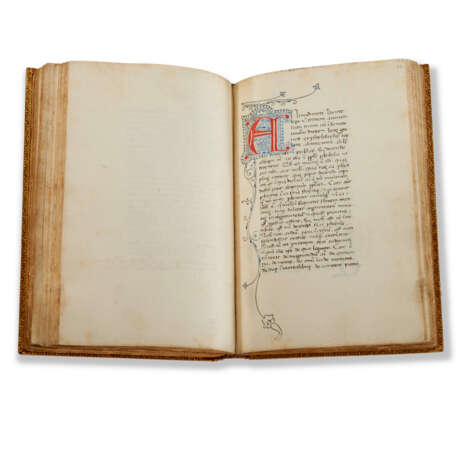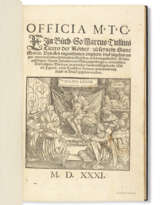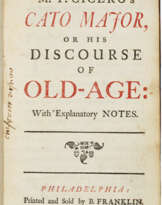ID 869530
Лот 123 | Cicero (106-43 BCE)
Оценочная стоимость
£ 12 000 – 18 000
De Officiis, Paradoxa Stoicorum and De Amicitia, preceded by the Epitaphia Ciceronis (or Carmina Duodecim Sapientum) and Martinus Bracarensis, Formula Honestae Vitae, in Latin, decorated manuscript on paper [Italy, possibly Venice?, mid-15th century].
A handsome humanist manuscript containing three seminal texts by the great Roman politician and orator Cicero, extensively annotated and glossed by a contemporary hand.
219 x 145mm. ii +162+ ii leaves, complete, collation: 17 (of 8, i a cancelled blank), 2-1312, 1411 (of 12, xii a cancelled blank), the Cicero texts with 27 lines, ruled space: 120 x 70mm, catchwords survive, initials and paraphs touched in red throughout, 5 large ornamental initials with penwork decoration extending into margins, smaller penwork initials alternately in red or blue with blue or red decoration, the first c.50 leaves of De Officiis with extensive contemporary annotations and glosses (occasional marginal damp-staining and spotting, small paper repairs to corners of ff.1 and 8). Modern brown morocco gilt (edges and spine scuffed).
Provenance:
(1) Walter Sneyd (1809-1888), bibliophile, antiquarian, minister and amateur caricaturist: his armorial bookplate on inside upper cover and his sale, Sotheby’s, 16 December 1903, lot 191.
(2) R. Ranshaw: pencil inscription on verso of first flyleaf. This must be Robert Ranshaw (1836-1924) of Louth, master draper, Captain in the 3rd Lincolnshire Artillery Volunteer Corps and later art collector (he owned Rembrandt’s Entombment of Christ).
(3) Edith Mary Ranshaw (1871-1942), daughter of Robert Ranshaw: her sale, Sotheby’s, 9 February 1943 (‘The Property of Miss E. M. Ranshaw’), lot 31.
(5) Colker MS 13; acquired in 1944 from Maggs; Faye & Bond, Supplement to de Ricci’s Census (1962), p. 517.
Content:
Epitaphia Ciceronis (from Carmina duodecim sapientum), beginning ‘Hic iacet arpinas [...]’ ff.1-2v; Martinus Bracarensis, Formula Honestae Vitae, ff.3-7; Marcus Tullius Cicero, De Officiis ff.8-112: book 1 f.8, book 2 f.54v, book 3 f.79; Paradoxa Stoicorum ff.113-125v; De Amicitia ff.126-155v; Index of Chapters for the De Officiis ff.156-160v; ruled blanks ff.161-162v.
De Officiis was the last of Cicero’s philosophical works, written at a time of political crisis after the assassination of Julius Caesar, when the Republican status quo was on the brink of collapse. Formulated as a letter to his son, it is Cicero’s exposition as an elder statesman on the best way to live and on what is honourable. The second text, De Amicitia, was written at a similar time, before the conflict with Antony, and was dedicated to Cicero’s friend Titus Pomponius Atticus (109-32 BCE). He based this work on early Greek philosophers such as Plato and Theophrastus. The text is written as a dialogue between prominent figures, namely Gaius Laelius and his sons-in-law Gaius Fannius and Quintus Mucius Scaevola – teacher to Cicero himself. Cicero's Paradoxa stoicorum, the third text, was only rediscovered in the early 15th century. Florence may have been the centre of dissemination of the Paradoxa: since 1418 Cosimo de’ Medici was known to own an early Monte Cassino manuscript of the text. The Paradoxa is an introduction to Stoicism in which Cicero lays out six stoic principles and tries to make them understandable for the ‘average’ reader.
The three texts are here preceded by verse epitaphs on Cicero which form part of a group of 143 third- or fourth-century epigrams known as Carmina duodecim sapientum, purportedly the compositions of the twelve sages Palladius, Asclepiadus, Eusthenius, Pompilianus, Maximianus, Vitalis, Basilius, Asmenius, Vomanius, Euphorbius, Julianus and Hilasius. The Carmina survive in over 400 manuscripts (see M. Rossellini, ‘Sulla tradizione dei Carmina Duodecim Sapientum (Anth. Lat. 495-638)’, RFIC 122 (1994), pp. 436-63; and ‘Di nuovo sui “Carmina duodecium sapientum”, Rivista di Filologia e di Istruzione Classica (2002), pp.105-125) and their authorship, textual transmission and structure has been the subject of intense academic debate - Anne Friedrich concluded in 2002 that the collection was to be identified with the first entry in Jerome’s catalogue of the works of Lactantius (see A. Friedrich, Das Symposium der XII sapientes : Kommentar und Verfasserfrage. Texte und Kommentare, 2002. The epitaphs on Cicero are particularly important because they are our only source for the name of the man who buried the orator, his friend Lamia.
The present manuscript is mentioned in M. Winterbottom, The Classical Quarterly 43 (1993), p.237.
| Автор: | Марк Туллий Цицерон (106 до н.э. - 43 до н.э.) |
|---|---|
| Категория аукционного дома: | Манускрипты Средневековья и Ренессанса |
| Автор: | Марк Туллий Цицерон (106 до н.э. - 43 до н.э.) |
|---|---|
| Категория аукционного дома: | Манускрипты Средневековья и Ренессанса |
| Адрес торгов |
CHRISTIE'S 8 King Street, St. James's SW1Y 6QT London Великобритания | |
|---|---|---|
| Предосмотр |
| |
| Телефон | +44 (0)20 7839 9060 | |
| Комиссия | see on Website | |
| Условия использования | Условия использования |















